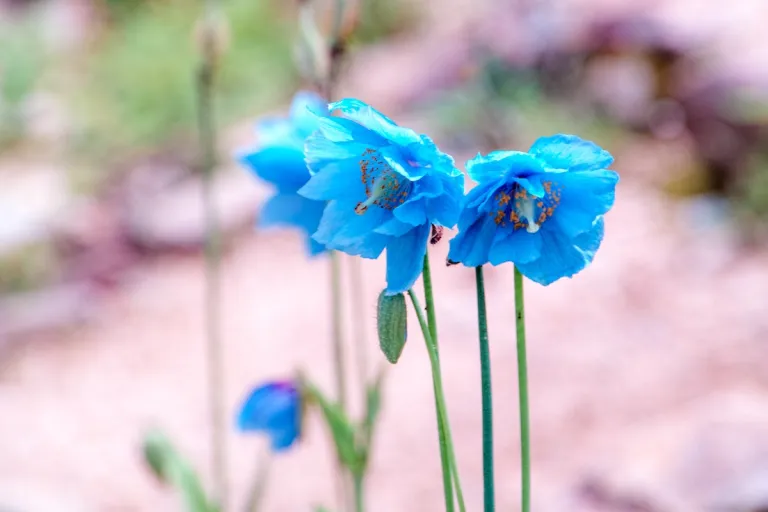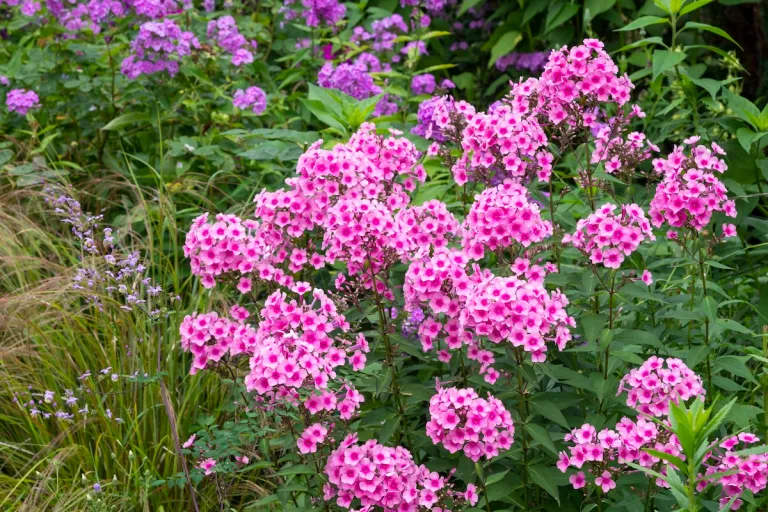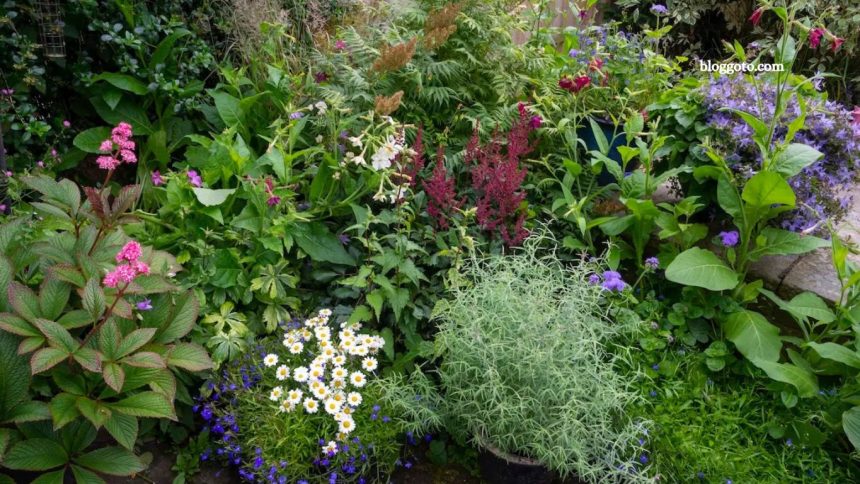Think shade-loving flowers are dull or delicate? Think again. Many stunning annuals and perennials flourish in partial or full shade, offering vibrant color without direct sun.
These 10 shade-tolerant plants feature bold blooms or abundant blossoms that bring life to darker corners of your garden. Try them for a lush, low-light landscape that truly shines.
Begonia (Begonia spp.)

Begonias rank among the best container flowers for shade, offering abundant blooms in a range of sizes and styles. Tuberous begonias produce large, rose-like double flowers and can be overwintered indoors for a second season. Wax begonias deliver smaller, single blooms in greater numbers and often thrive under grow lights through winter. While most begonias are grown as annuals, Begonia grandis is a hardy perennial option.
Hardiness Zones: 10–11 (annual types), 6–9 (Begonia grandis)
Best For: Borders, containers, indoor houseplants
Read More: Tess Holliday Empowers You to ‘Take Up Space’ in Bold New Book
Blue Poppy (Meconopsis betonicifolium)

The Himalayan blue poppy (Meconopsis betonicifolia) is prized for its rare, true-blue blooms and shade tolerance, despite being challenging to grow. This striking perennial can reach up to 6 feet tall and 2 feet wide, producing silky, 3–4-inch sky-blue flowers with yellow stamens.
It thrives in the Pacific Northwest’s cool summers. For success, plant in moist, well-drained acidic soil and apply a thick mulch of dead leaves in Zones below 4.
Hardiness Zones: 3–7
Best For: Cottage, rock, and woodland gardens
Foxglove (Digitalis purpurea)

Foxglove (Digitalis purpurea) grows 2 to 5 feet tall with tubular, freckled blooms in shades of purple, white, and pink that line its tall stalks. These biennials prefer afternoon shade and typically flower in their second year before dying, though they often self-sow for future blooms.
Note: All parts of the plant are toxic to humans and pets if ingested.
Hardiness Zones: 4–9
Best For: Cottage gardens, pollinator gardens, woodland settings
Fritillary (Fritillaria spp.)

Fritillaries bring charm and curiosity to shade gardens with their distinctive bell-shaped blooms. Ranging from the petite guinea hen flower (Fritillaria meleagris) at 1 foot tall to the 3-foot Fritillaria persica with striking clusters of purple bells, these bulb-grown plants add graceful height and texture.
Plant bulbs on their sides to prevent rot. After blooming, fritillaries die back naturally and require no maintenance.
Hardiness Zones: 4–10 (varies by species)
Best For: Cottage, rock, and woodland gardens
Fuchsia (Fuchsia spp.)

Hybrid fuchsias are top picks for shaded containers and hanging baskets, thanks to their vibrant, flouncy blooms. Hardy cultivars like Fuchsia magellanica offer a garden-worthy option, surviving in-ground winters as far north as Zone 5, though they die back to the soil in cold seasons.
Fuchsias thrive in cool conditions and need protection from intense afternoon sun. If they wilt in summer heat, don’t worry—they often bounce back in the cooler days of fall.
Hardiness Zones: 10–12 (hybrids), 5–10 (Fuchsia magellanica)
Best For: Containers, pollinator gardens, shaded walls
Garden Phlox (Phlox paniculata)

Garden phlox grows up to 5 feet tall and features fragrant, rounded clusters of 1-inch blooms—often with darker centers—in a range of vibrant colors. While it tolerates full sun, partial shade helps maintain richer hues in hot climates.
To prevent powdery mildew, space plants well and mulch to keep roots cool. These perennials thrive in cottage, woodland, and pollinator gardens.
Hardiness Zones: 4–8
Best For: Cottage gardens, pollinator gardens, woodland gardens
Hellebore (Helleborus spp.)

Hellebores are top-performing full-shade perennials, blooming in winter in warmer regions and early spring in cooler zones. Their 2- to 3-inch, rose-like flowers—actually leathery sepals—have earned them names like “Christmas rose” (Helleborus niger) and “Lenten rose” (Helleborus orientalis).
These evergreen plants grow 12–15 inches tall and thrive in “high shade” beneath trees. Use organic fertilizer for best results. Like foxglove, all parts of the plant are highly toxic.
Hardiness Zones: 5–8
Best For: Cottage gardens, winter interest, woodland gardens
Impatiens (Impatiens spp.)

Single-flowered Impatiens walleriana hybrids—known for their 1- to 2-inch, five-petal blooms—remain classic annuals for shade. However, many other varieties exist, including Impatiens glandulifera (ornamental jewelweed), a hardy but potentially invasive type with hooded flowers.
The rare ‘Blue Diamond’ namchabarwensis stands out with its unique blue blooms. Most impatiens thrive and flower heavily in full to partial shade, making them a versatile choice for low-light gardens.
Hardiness Zones: 10–11 (most varieties), 5–9 (Impatiens glandulifera)
Best For: Borders, containers, woodland gardens
Martagon lily (Lilium martagon)

Martagon lilies thrive in part shade, making them rare among lilies that typically prefer sun. According to the Missouri Botanical Garden, more shade results in taller flowering stems and showier blooms.
Though slow to establish, they’re easy to grow. Each stem can produce up to 50 small, nodding flowers—1 to 2 inches wide—with recurved petals, adding elegance to shaded gardens.
Hardiness Zones: 3–8
Best For: Cottage gardens, meadow gardens, woodland gardens
Surprise Lily (Lycoris spp.)

Lycoris, or spider lilies, are striking bulbs perfect for woodland gardens. Their 2-foot stalks emerge almost overnight in late summer to early fall, crowned with vibrant red, orange, pink, or blue blooms.
The strap-like foliage appears in spring without flowers, then dies back by midsummer. These bulbs need summer heat to thrive, so they aren’t ideal for the cooler Pacific Northwest.
Hardiness Zones: 5–9
Best For: Patio gardens, pollinator gardens, woodland gardens
Frequently Asked Questions
What are the best flowers for full shade?
Some of the best flowers for full shade include hellebores, astilbe, foxglove, and impatiens. These plants bloom beautifully even with minimal sunlight.
Can I grow flowering plants in deep shade?
Yes, but options are more limited. Choose shade-tolerant plants like ferns, hostas (for foliage), and hellebores, which can bloom in deep or filtered shade.
How many hours of sunlight do shade-loving flowers need?
Most shade-tolerant flowers need 2–4 hours of indirect or dappled sunlight. Some tolerate less, while others prefer morning sun and afternoon shade.
Do shade flowers attract pollinators?
Absolutely. Many shade flowers like foxglove, fuchsia, and phlox attract bees, hummingbirds, and butterflies.
What are some low-maintenance shade flowers?
Great low-maintenance shade flowers include astilbe, lungwort, brunnera, and hardy fuchsia. They require minimal care once established.
Can I grow annuals in shade?
Yes, shade-tolerant annuals such as impatiens, begonias, and coleus thrive in containers or garden beds with filtered light.
Will flowers still bloom in shaded gardens?
Yes, many flowers not only survive but bloom vividly in shade. Choosing the right species and providing proper soil and moisture ensures success.
What are the best shade flowers for containers or hanging baskets?
Begonias, fuchsias, impatiens, and lobelia are ideal for shady containers or hanging baskets due to their compact growth and vibrant blooms.
Conclusion
Shady areas don’t have to be dull or lifeless. With the right selection of flowers—like impatiens, foxglove, hellebores, and fuchsias—you can transform low-light corners into vibrant, blooming spaces. Whether you’re working with deep shade, partial shade, or dappled light, there’s a wide variety of perennials and annuals that thrive without full sun. Choose plants suited to your hardiness zone and garden style, and enjoy a colorful, pollinator-friendly landscape year-round—even in the shade.










